Radio Taiso, Japan’s quintessential exercise program, has become a hallmark of health and culture, with a staggering 96.9% of the national population recognising its significance.
Initiated in 1928 by the Postal Life Insurance Bureau of the Ministry of Communications, Radio Taiso was established as a ‘National Health Exercise’ aimed at bolstering the health of Japanese citizens. Broadcasted daily by the Japan Broadcasting Corporation, this program transcends mere physical fitness, embedding itself deeply in the fabric of Japanese daily life.
Comprising two exercise patterns – Radio-Taiso No. 1 and 2, the program incorporates 13 rhythmic movements, harmoniously choreographed to music. Each session is thoughtfully structured to start and end with gentle intensity, safely accommodating participants of all ages. Its comprehensive approach, targeting strength, flexibility, endurance, and balance, positions Radio Taiso as a multifaceted exercise programme rich in cultural and social significance.
The health benefits of Radio Taiso are widely acknowledged and scientifically supported, demonstrating improvements in metabolic rate, muscle mass, respiratory function, and bone density. Furthermore, it has effectively reduced upper body fluid retention, highlighting its utility in diverse health scenarios. The program’s cultural prominence and health benefits have garnered attention in research circles, with studies exploring its impact on various health parameters.
The post will uncover Radio Taiso’s history, health benefits, and enduring appeal across generations. We will also examine how this traditional exercise program has maintained its relevance in modern times and its potential role in shaping global health perspectives.
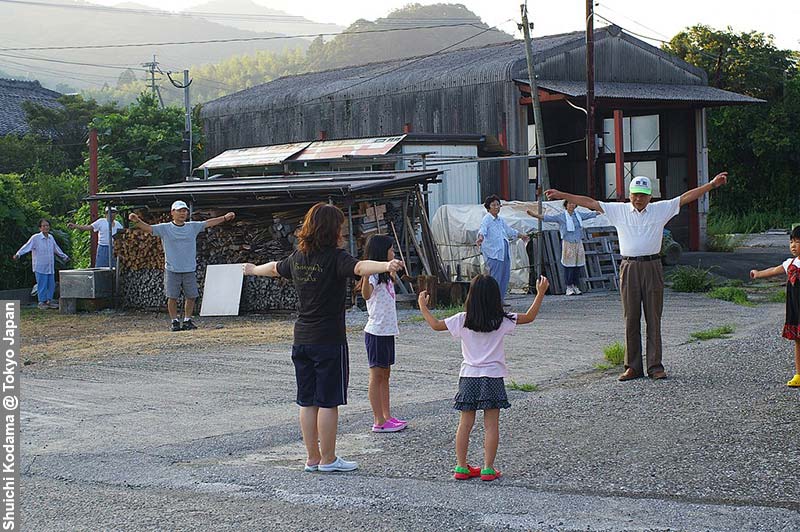
The Historical Roots of Japan’s Morning Exercise
Radio Taiso was conceived in 1928 by the Postal Life Insurance Bureau of the Ministry of Communications. Now, Japan Post Insurance has designed it as a ‘National Health Exercise’ to enhance the well-being of the Japanese populace. This initiative began a journey that would see Radio Taiso become an integral part of Japanese culture.
The exercise, known as “Radio Exercise”, boasts a rich 90-year history. Initially, it was broadcast by the Japan Broadcasting Corporation, popularising the routine nationwide. By 1951-1952, the exercises were reorganised into “Radio Exercises 1 and 2”, which remain popular today.
1999 “Everyone’s Exercises” was introduced, honouring the United Nations’ International Year of Older Persons. This new form was designed with a ‘universal design’ approach, making it accessible and enjoyable for people of all ages and abilities, regardless of gender or disability.
Radio Taiso comprises three exercise patterns: Radio-Taiso No. 1 and 2, consisting of 13 rhythmic movements with music. The patterns start with low-intensity movements, gradually intensify, and conclude with low-intensity movements again, ensuring safe participation for people of varying abilities. This deliberate structuring has facilitated widespread acceptance and participation.
The program has deeply embedded itself in various aspects of Japanese life. Radio Taiso is commonly practised in schools, workplaces, and community gatherings, becoming a cultural mainstay. This integration into daily life underlines its importance in Japanese society.
Reflecting its growth and popularity, over 24,600 certified Radio-Taiso instructors have been trained, with the programme now practised at over 2000 regional bases nationwide. This growth is indicative of Radio Taiso’s enduring appeal and effectiveness.
The program’s inception occurred when Japan faced significant health challenges. In the 1920s, the average life expectancy was only 42 years, and tuberculosis was widespread. Concerned with improving public health, Japanese health insurance bureau representatives visited the Metropolitan Life Insurance Company in the United States. Inspired by the exercise routines there, they brought the concept of daily exercise broadcasts back to Japan.
By the mid-1920s, Radio Taiso was launched on a large scale. To familiarise the population with the routines, 20,000 workers of the national postal service performed them on the streets each morning. The broadcast of Radio Taiso has been a daily occurrence ever since, pausing only briefly after World War II to modify some movements deemed too militaristic.
An exciting facet of Radio Taiso’s history is its connection to school attendance initiatives from the same era. Stamps were initially given out at ‘hayaokikai’ or ‘early-riser meetings’ to ensure children attended school on time.
Children were made to perform Radio Taiso at these meetings to further this initiative before receiving their stamps. This strategy ensured punctuality and invigorated the children, making them too energised to return to bed.
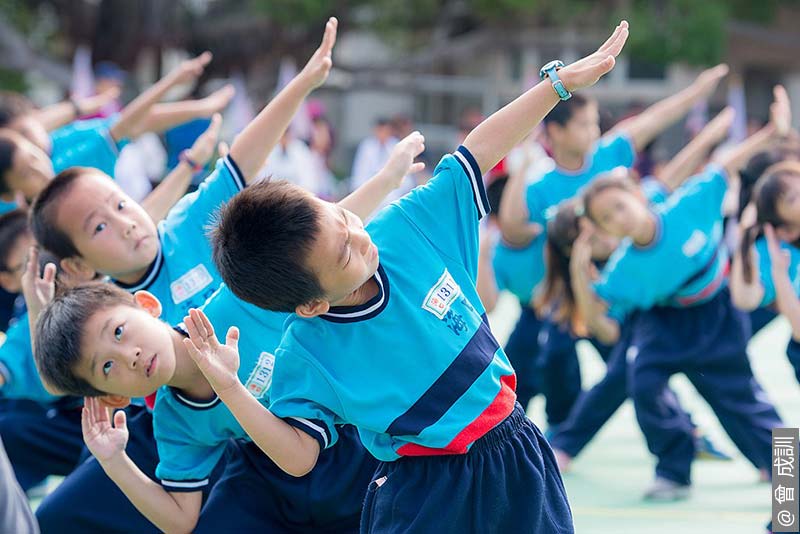
The Simplicity and Benefits of Radio Taiso
Radio Taiso stands out for its uncomplicated yet practical approach to physical activity. It revolves around Radio-Taiso No. 1 and 2, patterns that involve 13 carefully choreographed movements. These exercises are set to an uplifting musical backdrop, enhancing the enjoyment and rhythm of the workout.
The structure of Radio Taiso is thoughtfully designed to cater to all ages and abilities. The exercises commence with gentle movements, slowly building in intensity, and then taper off towards the end. This gradual progression ensures that participants can engage safely, making it an inclusive fitness routine.
Radio Taiso’s movements are not just physical exercises; they blend various fitness components, including endurance, strength, flexibility, and balance. This comprehensive approach makes Radio Taiso more than just a workout – it’s a holistic health routine that caters to the body’s multiple needs.
The beauty of Radio Taiso lies in its adaptability. It requires no special equipment and can be performed in a small space, making it a convenient option for individuals of all lifestyles. Whether one is at home, in the office, or even in a park, Radio Taiso can be easily incorporated into daily routines.
Radio Taiso is a communal experience, often performed in groups, fostering a sense of camaraderie and collective well-being. This aspect of the exercise enhances its appeal, making it a fun and engaging way to start the day, promoting physical movement, social interaction, and wellness.
This exercise program has been integrated into the lives of the Japanese people from a young age. Many adults in Japan recall participating in Radio Taiso during their school days, often as part of summer holiday routines.
The practice of completing these exercises in neighbourhood groups, with attendance cards stamped as a form of encouragement, has made Radio Taiso a fond childhood memory for many.
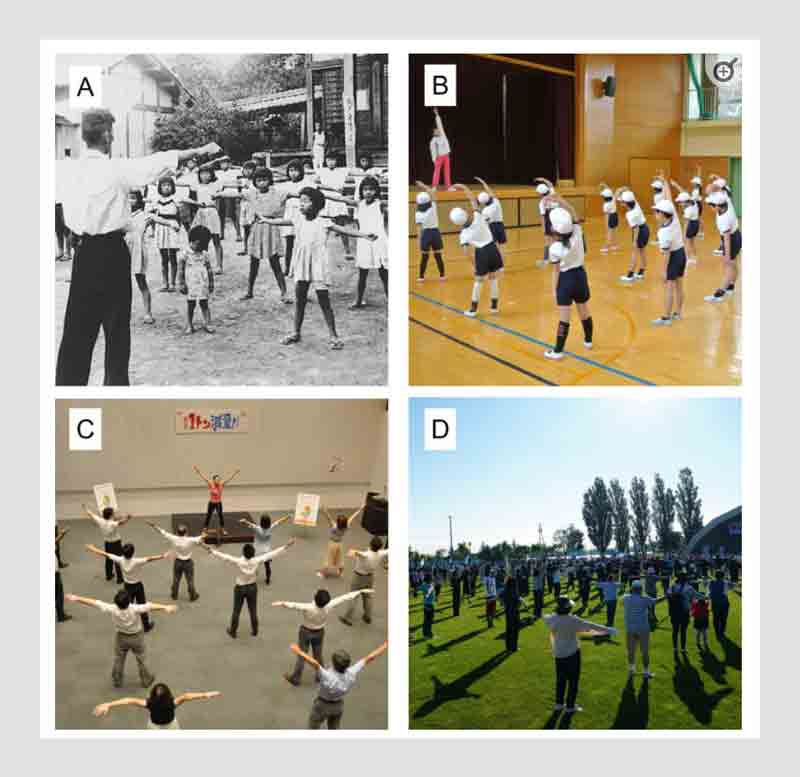
Radio Taiso Today Embracing Generations
Radio Taiso has gracefully adapted to modern times, retaining its charm across generations. Its integration into daily life in schools, workplaces, and community gatherings reflects its universality and enduring relevance in Japanese culture.
The program’s flexibility is evident through its multi-generational appeal. For schoolchildren, Radio Taiso is an introduction to fitness; in workplaces, it offers an essential physical break. Older adults find it a gentle, effective way to maintain health and mobility.
Instructors, over 24,600 nationwide, are pivotal in evolving the program to meet contemporary fitness needs, ensuring its traditions thrive in a modern context. Their role highlights Radio Taiso’s dynamic nature and ability to adapt to societal changes.
Digitally, Radio Taiso’s presence on platforms like YouTube broadens its reach, ensuring accessibility even beyond traditional group settings. This adaptation demonstrates the program’s commitment to staying relevant in a digitally connected world.
The program’s routines, tailored to different fitness levels, ensure inclusivity. While Dai-ichi is universally familiar and accessible, Dai-ni and Dai-san cater to those seeking more vigorous activity, thus encompassing all age groups.
Expressions like “I want to continue doing it forever” encapsulate the sentiment towards Radio Taiso. It’s not just an exercise but a lifestyle choice, reflective of a commitment to lifelong health and well-being.
Radio Taiso’s significance extends to health benefits, particularly for older adults, where light exercise routines contribute positively to maintaining independence and mobility. This underlines Radio Taiso’s role as a vital component in healthy ageing.
Its ability to unite different ages under the banner of health and community illustrates its timeless appeal and importance in today’s fast-paced world.
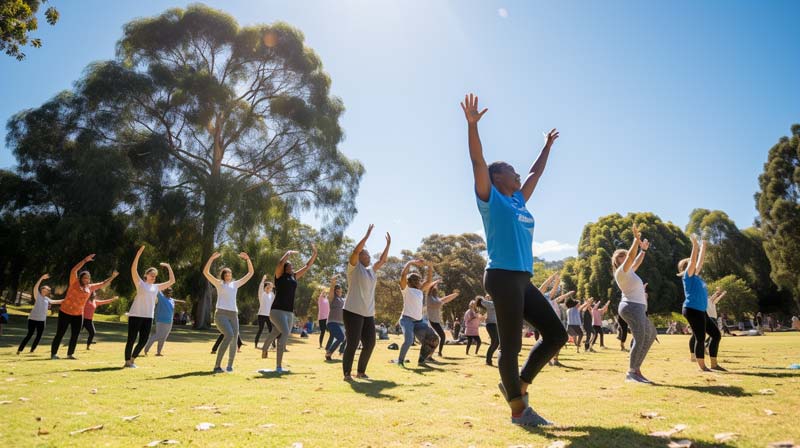
The Health Secrets Behind Radio Taiso
Radio Taiso, a cornerstone of Japanese health culture, offers a range of significant health benefits backed by scientific research.
These benefits contribute to physical wellness and cater to the unique health needs of different age groups. Here’s a deeper look into these health secrets:
- Enhanced Basal Metabolic Rate: Regular participation in Radio Taiso activities has been linked to an increase in the basal metabolic rate, which is vital for maintaining a healthy weight and improving overall metabolism.
- Improved Muscle Mass: The exercises target various muscle groups, contributing to increased overall muscle mass, which is crucial for strength and mobility, especially in older adults.
- Better Respiratory Function: The rhythmic breathing and movements in Radio Taiso help improve lung capacity and efficiency, which is essential for respiratory health.
- Increased Bone Density: Engaging in these exercises regularly can lead to improved bone density, reducing the risk of osteoporosis and bone-related ailments.
- Flexibility and Joint Mobility: The program includes movements that enhance flexibility and joint mobility, critical components in managing and preventing conditions like arthritis and joint pain.
- Balance and Coordination: Radio Taiso incorporates exercises that improve balance and coordination, particularly in preventing falls and injuries in the elderly.
- Positive Impact on Mental Health: While the link between exercise and mental health in older adults is still being explored, Radio Taiso’s routine physical activity contributes to cognitive health and well-being.
- Lymphatic Drainage and Reduced Swelling: The gentle motions stimulate fluid changes, leading to acute lymphatic drainage and movement, reducing swelling and improving function.
- Holistic Health Approach: The program’s design to stimulate about 400 muscles in just 3 minutes makes it a comprehensive exercise routine akin to a ‘nutritional supplement’ for physical activity.
Radio Taiso stands out as a multifaceted exercise program, integrating various physical fitness indices, making it an effective tool for overall health and a model for global health trends.
Easy Steps to Make Radio Taiso Part of Your Daily Life
Incorporating Radio Taiso into your daily routine offers a straightforward path to enhancing health and fitness. We’re exploring Radio Taiso No. 1 and No. 2, which feature sequences adaptable for standing and sitting positions, making them accessible and inclusive for everyone.
These routines’ insights and visual guides have been sourced from the Japan Post Insurance website, ensuring an authentic representation of these traditional exercises.
Radio Taiso No. 1 – A Comprehensive Exercise for Everyone
Radio Taiso No. 1 includes 13 movements that are effectively the same whether performed standing or sitting, designed to improve posture, flexibility, and cardiovascular health, and cater to a broad audience.
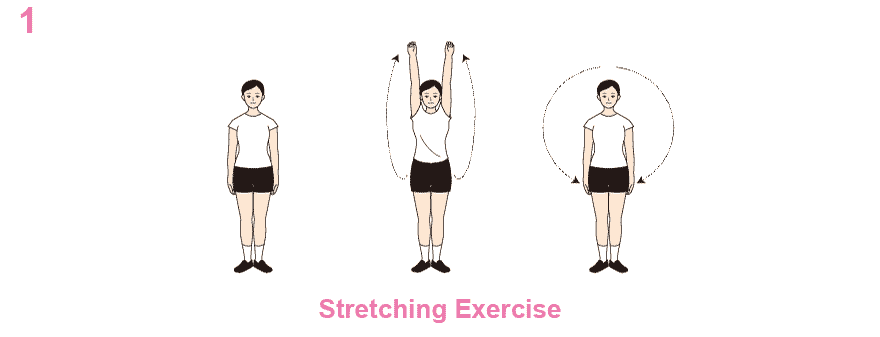
The standing sequence of Radio Taiso No. 1 emphasises enhancing posture, flexibility, and gentle cardiovascular stimulation. For a visual representation of these exercises, see the “Radio Taiso No. 1 – Standing Sequence” gif above.
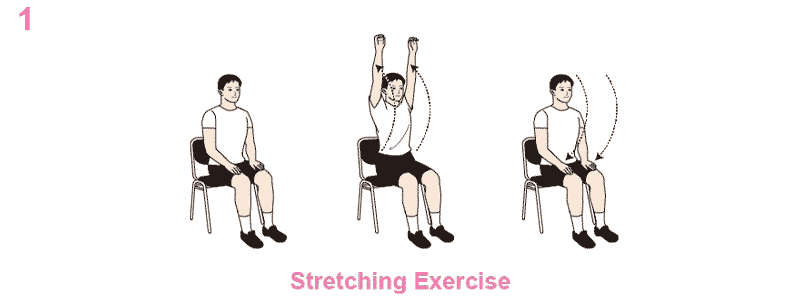
The setting sequence of Radio Taiso No. 1 is ideal for those who prefer or require a seated routine, focusing on increasing flexibility and stimulating blood flow. For a visual guide to these exercises, refer to the “Radio Taiso No. 1 – Sitting Sequence” gif above. The sequence of movements in Radio Taiso No. 1 are:
- Stretching Exercise: Extend your arms, slowly raising them to straighten your back, promoting good exercise posture and stretching your back muscles.
- Arm Swing and Leg Bend/Stretch: Involve rhythmic movements of heels and arm swings to enhance blood circulation.
- Arm Rotation: Focus on relaxing your arms and shoulders to maintain shoulder flexibility.
- Chest Arching: Promote respiratory function and correct posture by taking deep breaths.
- Side Body Bend: Stretch the often-neglected flank muscles by raising your arms and bending sideways without leaning forward.
- Forward and Backward Body Bend: Aid the flexibility of your back and abdomen, reducing lower back strain.
- Body Twist: An excellent exercise for spine flexibility, ensuring good posture.
- Arm Stretch Up and Down: Improve explosive power with quick, powerful movements.
- Diagonal Downward Bend and Chest Arch: Enhances respiratory function and stretches the back and leg muscles.
- Body Rotation: Improves flexibility around the waist.
- Both Legs Jumping: Rhythmic jumping helps promote overall body circulation.
- Arm Swing and Leg Bend/Stretch: A sorting exercise to control breathing and normalise heart rate.
- Deep Breath: Focus on deep breathing, easing the body to normal.
Now, let’s move on to Radio Taiso No. 2, which provides an inclusive and adaptable routine for all fitness levels.
Radio Taiso No. 2 – Dynamic and Engaging Routine
Radio Taiso No. 2 introduces a dynamic set of movements, combining fluid arm actions, leg exercises, and balance work. This version is designed to build strength and coordination, catering to various fitness levels.
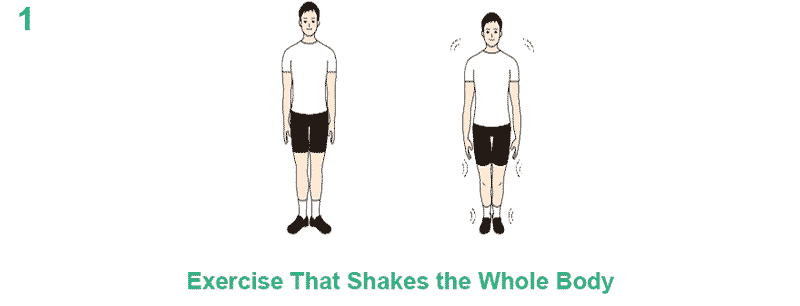
The standing sequence in Radio Taiso No. 2 is a blend of dynamic movements for balance and coordination. To experience these exercises visually, check out the “Radio Taiso No. 2 – Standing Sequence” gif above.

The sitting sequence of Radio Taiso No. 2 caters to those preferring or requiring a seated workout. It targets the upper body and core, promoting flexibility and muscle tone. Refer to the gif titled “Radio Taiso No. 2 – Sitting Sequence” above for a visual guide. The sequence of movements in Radio Taiso No. 2 are:
- Whole Body Shake: A gentle way to relax the entire body, preparing for the exercises.
- Arm and Leg Bend/Stretch: Vibrant leg movements with raised heels and arm movements stimulate blood circulation.
- Arm Opening and Rotation: Relax shoulder muscles and enhance flexibility with straight elbow movements.
- Chest Arching: Slow, deep breathing coupled with arm movements to promote lung function.
- Side Body Bend: Soften stiff flank muscles using the hand under the armpit as a fulcrum for rhythmic side bends.
- Forward and Backward Body Bend: Increases back and abdominal flexibility, reducing lower back strain.
- Body Twist: A spine-flexing exercise that aids in establishing good posture.
- Single-Leg Jump and Kick/Stomp: Light, rhythmic exercises enhance leg strength and explosive power.
- Twist and Arch Body Movement: Dynamic movements that relax the entire torso.
- Body Bending: Strengthens back muscles, creates good posture, and focuses on maintaining forward vision.
- Both Feet Jumping: Light, rhythmic jumping that enhances circulatory system function.
- Arm Swing and Leg Bend/Stretch: A breathing control exercise to help the heart rate return to normal.
- Deep Breath: Slowly brings the body back to normal with natural palm movements synchronised with deep breaths.
Incorporating Radio Taiso No. 1 and No. 2 into your routine has merits. You can achieve a balanced approach to fitness that enhances physical and mental well-being, suitable for all ages and abilities.
The Cultural and Community Essence of Radio Taiso
Radio Taiso, deeply embedded in Japanese culture, represents more than just a fitness regimen. It symbolises communal harmony and national identity. Practised in schools, workplaces, and community gatherings. It’s a staple in daily Japanese life, fostering social cohesion and collective health consciousness.
This exercise program, rich in cultural and social significance, is a potential public health strategy owing to its widespread acceptance and ease of implementation. With over 24,600 certified instructors and practice at more than 2000 regional bases nationwide, Radio Taiso’s growth mirrors its popularity and effectiveness.
Radio Taiso’s communal aspect is highlighted by many individuals who are noted about the program’s ability to overcome individual shyness in group settings. Exemplifying its role in fostering collective participation.
The practice is instilled in Japanese children from a young age, becoming synonymous with their summer holidays. These routines, conducted in neighbourhood groups with attendance cards, have become a cherished childhood memory for many Japanese adults.
The attendance cards, a historical element dating back to the 1920s, were initially part of a school punctuality initiative. Children performed Radio Taiso at early riser meetings before receiving stamps on their cards, a clever strategy to keep them awake and active, preventing them from returning to bed.
The Japanese government highlights the program’s significant impact. Noting the production of 30 million copies of these attendance cards, substantially spreading the exercises nationwide.
Radio Taiso, therefore, stands as a testament to Japan’s commitment to health, community, and cultural heritage. It’s a daily ritual that nurtures both physical well-being and social bonds, an exercise in unity as much as in fitness.
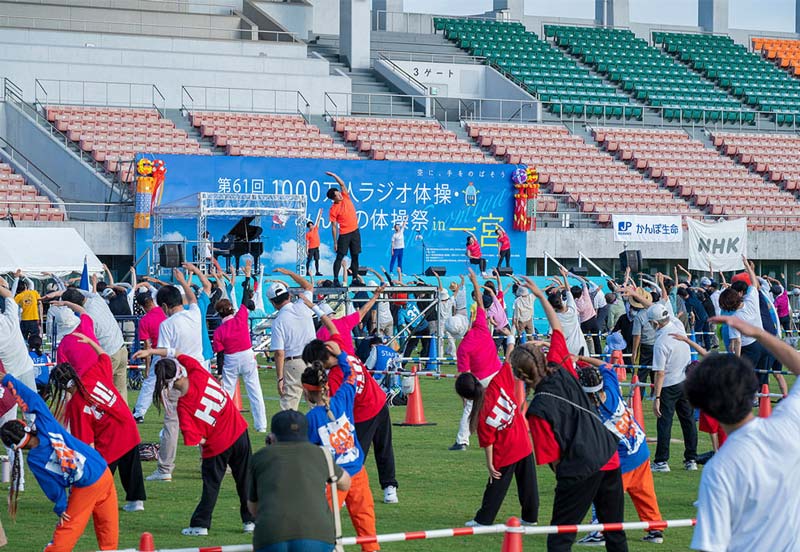
Radio Taiso’s Role in Shaping Future Global Health Trends
Radio Taiso, with its deep cultural roots and comprehensive health benefits, is poised to significantly influence global health trends. Its simplicity, effectiveness, and social nature make it a potential blueprint for worldwide wellness initiatives. Particularly in the context of ageing populations and the increasing prevalence of lifestyle-related health issues.
- A Model for Global Wellness Initiatives: Radio Taiso’s accessibility and comprehensive approach to health, focusing on flexibility, joint mobility, and balance, position it as an ideal model for global wellness programs. These components are essential in frailty interventions and crucial for restoring vigour in ageing populations. With modifications to suit different cultural contexts, Radio Taiso could become a worldwide cornerstone in public health strategies.
- Adapting to Diverse Populations: While initially rooted in Japanese culture, the adaptability of Radio Taiso suggests its potential adoption in other East Asian regions and beyond. Its basic principles can be tailored to align with various cultural practices, transforming global perspectives on healthy ageing and wellness.
- Impact on Frailty and Quality of Life: The effectiveness of Radio Taiso in managing frailty among the elderly. This, especially during challenging times like the COVID-19 pandemic, indicates its potential as a viable health strategy. Large-scale trials could further validate its efficacy in improving mobility and quality of life among older adults.
- Frailty and Public Health: Understanding frailty as a decline in physiological resilience underscores the need for public health interventions like Radio Taiso. Implementing such programs within public healthcare systems could improve essential outcomes for the elderly, especially those with frailty and pre-frailty.
- Historical Roots and Evolution: Radio Taiso’s history, tracing back to the 1920s with adopting exercise routines from the United States, illustrates its potential for global influence. The program has already demonstrated adaptability and appeal across different cultures and generations.
- Universality and Accessibility: The program’s design, requiring no equipment and limited space, makes it universally accessible. Such features benefit diverse groups, including office workers, students, the young, and the elderly. This universality could see Radio Taiso adopted in various settings globally, from corporate wellness programs to community health initiatives.
- A Continued Legacy: Radio Taiso, much like a societal ritual, has ingrained itself deeply within the Japanese community. Its enduring appeal and effectiveness suggest that it will continue to be a significant part of daily life. Serving as a model for other societies seeking to integrate similar health practices.
Radio Taiso’s potential in shaping future global health trends lies in its unique blend of cultural richness, simplicity, and effectiveness. As societies worldwide grapple with the challenges of ageing populations and lifestyle-related health issues. Radio Taiso offers a blueprint for a communal, accessible, and holistic approach to wellness.
Sources
- Arinaga, Y., Sato, F., Piller, N., Ishida, T., Ohtake, T., Kikuchi, K., Sato-Tadano, A., Tada, H., & Miyashita, M. (2019). The 10-Min Holistic Self-Care for Patients with Breast Cancer-Related Lymphedema: Pilot Randomized Controlled Study. Tohoku Journal of Experimental Medicine, 247(2), 139–147.
- Clegg, A., Barber, S., Young, J., Iliffe, S., & Forster, A. (2014). The home-based older people’s exercise (HOPE) trial: A pilot randomised controlled trial of a home-based exercise intervention for older people with frailty. Age and ageing, 43(5), 687-695.
- Clegg, A., Young, J., Iliffe, S., Rikkert, M. O., & Rockwood, K. (2013). Frailty in elderly people. The Lancet, 381(9868), 752-762.
- Dent, E., Martin, F. C., Bergman, H., Woo, J., Romero-Ortuno, R., & Walston, J. D. (2019). Management of frailty: Opportunities, challenges, and future directions. The Lancet, 394(10206), 1376-1386.
- Government of Japan. Rajio Taiso: Japan’s National Exercises. [Accessed 26 November 2023].
- Japan Post Insurance. Radio gymnastics/Everyone’s gymnastics. [Accessed 26 November 2023].
- Japan Post Insurance Co., Ltd. Recognition and participation rates for “Radio-Taiso”; 2021. [Accessed 26 November 2023].
- Osuka, Y., Kojima, N., Sugie, M., Motokawa, K., Maruo, K., Ono, R., Aoyama, T., Inoue, S., & Kim, H. (2023). Adherence, safety and potential effectiveness of a home-based Radio-Taiso exercise program in older adults with frailty: A pilot randomized controlled trial. Geriatrics & Gerontology International, 23(1), 32-37.
- Public Relations Office. Government of Japan. Rajio Taiso Japan’s National Exercises. [Accessed 26 November 2023].
- Radio Taiso. Radio Calisthenics. [Accessed 26 November 2023].
- Saraiva MD, Apolinario D, Avelino-Silva TJ, de Assis Moura Tavares C, Gattás-Vernaglia IF, Marques Fernandes C, Rabelo LM, Tavares Fernandes Yamaguti S, Karnakis T, Kalil-Filho R, Jacob-Filho W, Romero Aliberti MJ. The Impact of Frailty on the Relationship between Life-Space Mobility and Quality of Life in Older Adults during the COVID-19 Pandemic. J Nutr Health Aging. 2021;25(4):440-447.
- The Japan Radio-Taiso Federation . Information of certified instructors and regional bases. [Accessed 26 November 2023].



